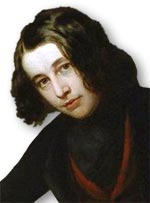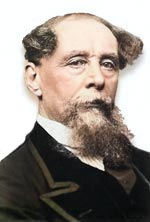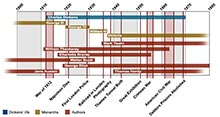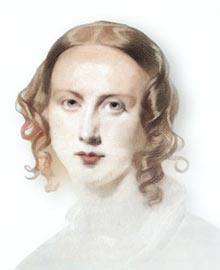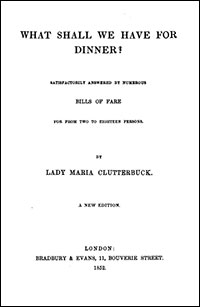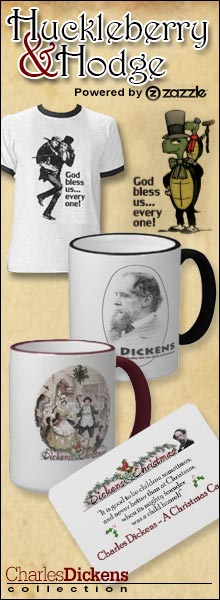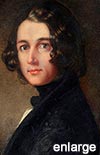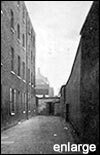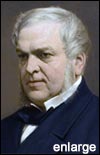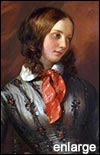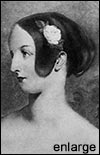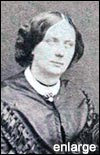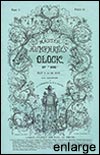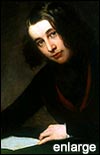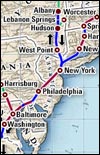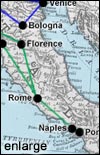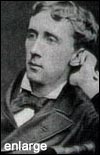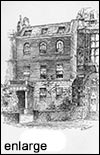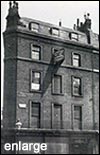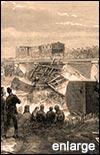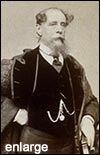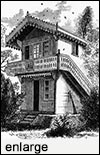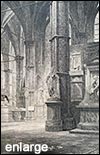The Life of Charles Dickens
An Illustrated Hypertext Biography of Charles Dickens
Childhood and Education
Charles John Huffam Dickens was born in Portsmouth, England on February 7, 1812. His father, John Dickens, was a clerk in the Navy Pay Office. John and Elizabeth Barrow married in 1809. Charles was the second of eight children born to John and Elizabeth. In 1817 John Dickens was transferred to the Navy Dockyards in Chatham. Charles began his limited formal education here at a school run by William Giles, whom he would remember fondly (Johnson, 1952, p. 20). The family lived in Chatham until 1822: Dickens later referred to this period as the happiest of his childhood (Davis, 1999, p. 58). Indeed, he was to return to this area at the end of his life. The Chatham/Rochester area provided the background for several of his novels.John Dickens, with a growing family and a Navy transfer to Somerset House in London, began to have financial troubles.
Charles was sent to work at Warren's Blacking factory when he was 12 years old, gluing labels onto pots of blacking (shoe polish) 10 hours a day, 6 days a week, for which he was paid a weekly salary of 6 shillings, most of which was used to help support the family. Soon after Charles began work at the blacking factory his father was arrested for debt and sent to the Marshalsea debtor's prison in Southwark.
At this point the family consisted of Charles, older sister Fanny, younger brothers Alfred and Frederick, and younger sister Letitia. Everyone except Charles and Fanny went to live in the Marshalsea with their parents. Fanny was boarding at the Royal Academy of Music, and Charles initially lodged with a landlady in Camden Town in north London. This proved to be too long a walk every day to the blacking factory and his family in the Marshalsea, so a room was found for him on Lant Street in Southwark near the prison.
Young Charles, who dreamed of growing up a gentleman, found these dreams dashed working alongside common boys at the blacking factory and later wrote "It is wonderful to me how I could have been so easily cast away at such an age." Dickens shared this painful part of his childhood through the story of David Copperfield although no one realized it was autobiographical until related by biographer John Forster after Dickens' death (Forster, 1899, v. 1, p. 22-39).
After John Dickens’ debt was paid and he was released from prison he took pity on young Charles and removed him from the blacking factory.
His mother, however, thought that he should stay to continue to provide income for the family. Years later Dickens would write "I do not write resentfully or angrily: for I know all these things have worked together to make me what I am: but I never afterwards forgot, I never shall forget, I never can forget, that my mother was warm for my being sent back" (Johnson, 1952, p. 44).Charles was to further his education at Wellington House Academy, a school run by the harsh schoolmaster William Jones, a man who delighted in corporal punishment and who Dickens later described as "by far the most ignorant man I have ever had the pleasure to know". Charles would spend nearly three years, aged 12-15, at Wellington House, leaving in the spring of 1827 (Slater, 2009, p. 25-27). Many of his experiences at school, and the masters who taught there, would later find their way into his fiction.
The Law and Early Journalism
In May 1827 Dickens began work as a law clerk with the firm of Ellis and Blackmore in Gray's Inn, London. He later moved to another law firm but after roughly two years in the legal business Dickens decided that the law moved too slowly and he grew bored with it (Ackroyd, 1990, p. 115-123). He obtained an admission ticket to the British Museum and haunted the library there reading everything he could get his hands on (Slater, 2009, p. 32). John Dickens, leaving the Navy Department with a small pension, found employment as a journalist at the Mirror of Parliament.
Young Charles taught himself shorthand and followed his father into employment at the Mirror of Parliament as a parliamentary reporter (Ackroyd, 1990, p. 132).Charles had been fascinated with the theatre since childhood and often attended the theatre to break the monotony of reporting on parliamentary proceedings. He wrote to George Bartley, manager of the Covent Garden Theatre, in 1832 asking for an audition, which was granted. On the day of the audition Charles was ill with a bad cold and inflammation of the face and missed the appointment. He wrote to Bartley explaining the illness and that he would apply for another audition next season. He would later marvel at how near he came to a very different sort of life (Ackroyd, 1990, p. 139-140).
While still working for the Mirror of Parliament Dickens also became a parliamentary reporter for a new paper, the True Sun. He began writing short stories during this time, one of which, A Dinner at Poplar Walk, was published in Monthly Magazine. Dickens was paid nothing for the story but was elated when he saw it in print (Forster, 1899, v. 1, p. 59). In 1834 he was hired as a reporter for the Morning Chronicle. Dickens found traveling the length and breadth of Britain as a reporter to be exciting work (Ackroyd, 1990, p. 155-156). The editors of the Morning Chronicle saw potential in the young reporter and asked him to write a series of sketches of everyday life in London. Soon Dickens also was writing sketches for other magazines and newspapers (Slater, 2009, p. 40-47).
One of these was the Evening Chronicle edited by George Hogarth. Hogarth invited Dickens, who was 23 at the time, to his home in Chelsea where he met, and was smitten by, Hogarth's nineteen-year-old daughter Catherine.Dickens, writing feverishly, as well as holding down the job of a reporter, now found himself in the throes of romance. He became a regular visitor to the Hogarth household and soon proposed marriage, which Catherine quickly accepted (Slater, 2009, p. 47). They were married at St. Luke's church, Chelsea on April 2, 1836. Two months previous his collection of short stories was published in book form by John Macrone entitled Sketches by Boz with illustrations by popular artist George Cruikshank (Ackroyd, 1990, p. 174). Dickens' pseudonym Boz came from his younger brother Augustus's through-the-nose pronunciation of his own nickname, Moses.
The Early Novels
Charles and Catherine Dickens set up housekeeping in Furnival's Inn. Charles' brother Fred, Catherine's sister Mary, and a servant rounded out the household.
In March, 1836 Dickens began writing a loose collection of the adventures of a sporting club titled The Pickwick Papers. Published in monthly installments at the suggestion of his new publishers, Chapman and Hall (Ackroyd, 1990, p. 177-178), the popularity of the series soared, especially after the introduction of Pickwick's servant, Samuel Weller, in chapter 10 (Johnson, 1952, p. 148-149). While Pickwick was still being serialized, Dickens began writing Oliver Twist, which appeared in weekly parts in the magazine, Bentley's Miscellany (Ackroyd, 1990, p. 215-218).On January 6, 1837, Catherine and Charles celebrated the birth of their first child, Charles Jr, called Charley. In March the growing family moved to new quarters at 48 Doughty Street. On May 7, after attending the theatre with Charles and Catherine, seventeen-year-old Mary became ill. She worsened during the night and died the next day in Charles’ arms (Slater, 2009, p. 100).
The family was devastated, none more so than Charles. He took a ring from Mary’s finger and wore it the rest of his life. Mary lives again in Dickens’ fiction in the character of some of his "perfect females" including Rose Maylie and Little Nell (Pugh, 1912, p. 68). Another of Catherine's sisters, Georgina, eventually took Mary's place in the Dickens household (Ackroyd, 1990, p. 337).While weekly episodes of Oliver Twist were appearing in Bentley's Miscellany, Dickens began monthly serialization of Nicholas Nickleby. To research the story Dickens and his illustrator, Hablot Knight Browne (Phiz) made a trip to Yorkshire, incognito, to investigate the notorious boarding schools there (Forster, 1899, v. 1, p. 112-113). After Nickleby, Dickens began a weekly magazine entitled Master Humphrey's Clock that featured, among other stories, the story of Little Nell and her grandfather called The Old Curiosity Shop.
This tale became so popular that it completely took over weekly editions of Master Humphrey's Clock to the exclusion of all other writing (Johnson, 1952, p. 297-298). With the conclusion of The Old Curiosity Shop, Dickens immediately started weekly publication, also in Master Humphrey's Clock, of Barnaby Rudge (Schlicke, 1999, p. 30).After the completion of Barnaby Rudge, Dickens decided to take some time off and persuaded his publishers, Chapman and Hall, to advance him money to make a trip to America, with the promise of a travel book upon return. Charles and Catherine now had four children: Charley (1837), daughters Mary (1838) and Katie (1839), and youngest son Walter (1841). It was decided that the children should be left at home with Dickens' friend, actor William Macready and his wife (Ackroyd, 1990, p. 334-335).
Charles and Catherine, along with Catherine's maid, Anne Brown, set sail aboard the steamship Britannia on January 3, 1842 and landed at Boston on January 22. He was instantly subjected to the American brand of hero worship that quite confounded him. He wrote home that "I can do nothing that I want to do, go nowhere where I want to go, and see nothing that I want to see. If I turn into the street, I am followed by a multitude" (Forster, 1899, v. 1, p. 229). Dickens’ initial enthusiasm turned to disappointment as the tour of America dragged on. He was hounded in the press for his continued harping on the issue of international copyright, stemming from the fact that although extremely popular in the States, he received nothing for his work sold there (Johnson, 1952, p. 380-382). To Macready he wrote "this is not the republic I came to see; this is not the republic of my imagination" (Letters, 1974, v. 3, p. 156).Upon returning home he penned the promised travel book, American Notes, a rather unflattering description of America, and followed that with Martin Chuzzlewit, published in monthly parts, in which the protagonist goes to America and is subjected to the same sort of puffed up, mercenary people Dickens found there. The story was not well received and did not sell well (Patten, 1978, p. 133). Neither had Barnaby Rudge (Schlicke, 1999, p. 33), and Dickens felt that perhaps his lamp had gone out.
Dickens found himself in dire financial straits. He had borrowed heavily from his publishers for the American trip and his family continued to grow with their fifth child, son Francis, on the way. His feckless father was borrowing money in Charles' name behind his back. He needed an idea for a new book that would satisfy his pecuniary problems (Slater, 2009, p. 215-220).
The seeds for the story that became A Christmas Carol were planted in Dickens' mind during a trip to Manchester to deliver a speech in support of education. Thoughts of education as a remedy for crime and poverty, along with scenes he had recently witnessed at the Field Lane Ragged School, caused Dickens to resolve to "strike a sledge hammer blow" for the poor (Ackroyd, 1990, p. 408-409). As the idea for the story took shape and the writing began in earnest, Dickens became engrossed in the book. He wrote that as the tale unfolded he "wept and laughed, and wept again' and that he 'walked about the black streets of London fifteen or twenty miles many a night when all sober folks had gone to bed" (Forster, 1899, v. 1, p. 326). Dickens was at odds with Chapman and Hall over the low receipts from Martin Chuzzlewit and decided to self-publish the book, overspending on color illustrations and lavish binding and then setting the cost low so that everyone could afford it (Slater, 2009, p. 220). The book was an instant success but royalties were low after production costs were paid.
Serialization of Martin Chuzzlewit came to a conclusion in July, 1844, and Dickens conceived of the idea of another travel book; this time he would go to Italy (Ackroyd, 1990, p. 426). The family spent a year in Italy, first in Genoa, and then traveling through the southern part of the country. He wrote the second of his Christmas Books, The Chimes (Slater, 2009, p. 230-231), while in Genoa and sent his adventures home in the form of letters which were published in the Daily News. These were collected into a single volume entitled Pictures from Italy in May, 1846 (Davis, 1999, p. 318).
Dickens followed the Italian trip with the monthly serialization of Dombey and Son. The book was remarkable for being the first where Dickens used notes he called mems to outline the story in advance.
This resulted in a much better structured novel and the finished book is much more cohesive than his previous novels had been (Slater, 2009, p. 258-260). The book sold well and Dickens gained a firm financial footing that would carry him the rest of his life (Watts, 1991, p. 86).During the 1840s Dickens, with a troupe of friends and family in tow, began acting in amateur theatricals in London and across Britain. Charles worked tirelessly as actor and stage manager and often adjusted scenes, assisted carpenters, invented costumes, devised playbills, and generally oversaw the entire production of the performances (Forster, 1899, v. 1, p. 436). The Dickens' amateur troupe even performed twice for Queen Victoria and Prince Albert (Davis, 1999, p. 4).
The Middle Years
In 1839 the Dickens family moved from Doughty Street to a larger home at Devonshire Terrace near Regent's Park. The family continued to grow with the addition of sons Alfred (1845), Sydney (1847), and Henry (1849).
Dickens continued to write a book for the Christmas season every year. After A Christmas Carol (1843), and The Chimes (1844), he followed with The Cricket on the Hearth (1845), The Battle of Life (1846), and The Haunted Man and the Ghost's Bargain (1848). All of these sold well at the time of publication but none endured as A Christmas Carol has (Schlicke, 1999, p. 97).
Dickens had begun writing an autobiography in the late 1840s that he shared with his friend and future biographer, John Forster (Forster, 1899, v. 1, p. 22). He found the writing too painful and opted instead to work his story into the fictional account of David Copperfield, which he later described as his personal favorite among his novels (David Copperfield, p. xii). The story was serialized from May 1849 until November 1850. During the writing of Copperfield the tireless Dickens began another venture, a weekly magazine called Household Words. Charles worked as editor as well as contributor with additional pieces supplied by other writers. Also during the writing of Copperfield Catherine gave birth to a daughter, named for David Copperfield's wife Dora (Slater, 2009, p. 312). Dora, sickly from birth, died at 8 months old (Ackroyd, 1990, p. 627-628).
Dickens followed David Copperfield with what many consider one of his finest novels, Bleak House (Davis, 1999, p. 35). Dickens used his previous experience as a court reporter to tell the story of a prolonged case in the Courts of Chancery. During the writing of Bleak House Catherine gave birth to a son, Edward (1852), nicknamed Plorn. Edward would be last of Charles and Catherine's children and the family moved again, this time to Tavistock House. Following Bleak House Dickens serialized his next book, Hard Times, in his weekly magazine, Household Words. Following Hard Times Dickens returned to the painful childhood memory of his father's imprisonment for debt with the story of Little Dorrit. Amy Dorrit's father, William, was a prisoner in the Marshalsea debtor's prison and Amy was born there.
During the 1850s Charles and Catherine's marriage started to show signs of trouble. Dickens grew increasingly dissatisfied with Catherine whom, after giving birth to ten children, had grown quite stout and lethargic. She was increasingly unable to keep up with her energetic husband (Schlicke, 1999, p. 155). The problem came to a head when Dickens became enthralled with a young actress he met during one of his amateur theatricals, Ellen Ternan. Charles and Catherine were separated in 1858 and caused a public stir mostly contributed to by Dickens' desire to exonerate himself (Johnson, 1952, p. 922-925). All of the Dickens children, with exception of Charley, would live with their father, as would Catherine's sister, Georgina. The relationship with Ternan, the depth of which is still being debated (Ackroyd, 1990, p. 914-918), would continue the rest of Dickens' life.
Dickens and his children now moved into the mansion Gads Hill Place in Kent that he had purchased in 1856 near his childhood home of Chatham. As a boy, Dickens would walk by the impressive house, built in 1780, with his father who told him that with hard work he could someday live in such a splendid mansion (Forster, 1899, v. 1, p. 6). In 1864 Dickens received, from actor friend Charles Fechter, a two-story Swiss chalet that Dickens had installed across the road from Gads Hill with a tunnel under the road for access (Ackroyd, 1990, p. 955-956). Dickens wrote his his final works in his study on the top floor of the chalet.
Alarmed at the misuse of the private letters of public men, and with some tracks of his own to cover, Dickens burned every letter he had ever received in a bonfire at Gads Hill on September 3, 1860 and quipped "Would to God every letter I had ever written was on that pile" (Watts, 1989, p. 72-74).The separation with Catherine also caused a rift between Dickens and his publishers, Bradbury and Evans. Bradbury and Evans also published the popular magazine Punch. When they refused to publish Dickens' personal statement, his explanation for the recent separation, Charles was furious and refused to have further dealings with them. He ceased publication of his weekly magazine, Household Words, continuing it under a new name, All the Year Round, and with his old publishers, Chapman and Hall (Kaplan, 1988, p. 395-401).
To bolster sales of the new weekly, Dickens decided to publish his next two books, A Tale of Two Cities, and Great Expectations, in weekly installments in the magazine. For A Tale of Two Cities Dickens used his friend, Thomas Carlyle's History of the French Revolution as a reference (Goldberg, 1972, p. 101). The second of his two historical fictions, the first being Barnaby Rudge, many felt that the historical accuracy of the book contributed to the rather un-Dickensian feel of the story (Watts, 1991, p. 115).
Great Expectations contained some of the autobiographical elements Dickens had included in David Copperfield (Epstein, 1998, p. 326). The book was tightly written, as demanded by the weekly format, and was very well received by his audience (Patten, 1978, p. 292).In the 1850s Dickens began reading excerpts of his books in public, first for charity, and, beginning in 1858, for profit. These readings proved extremely popular with the public and Dickens continued them for the rest of his life. The readings included excerpts from his Christmas books, David Copperfield, and Nicholas Nickleby, with A Christmas Carol, for which he wrote a condensed verion, and The Trial from Pickwick being the most popular (Davis, 1999, p. 328). He later included the dramatic murder of Nancy by Bill Sikes in Oliver Twist, the performance of which took a toll on Dickens' fragile health (Johnson, 1952, p. 1144).
The Later Years
In May, 1864, Dickens began publication of what would be his last completed novel. Published in monthly installments, Our Mutual Friend touches the familiar theme of the evils and corruption that the love of money brings. Poor health causing perhaps a stutter in his usual creative genius, Dickens found beginning the novel difficult, he wrote to Forster "Although I have not been wanting in industry, I have been wanting in invention" (Letters, 1998, v. 10, p. 414). After finally finding his footing, the monthly installments did not sell well despite a massive advertising blitz (Patten, 1978, p. 307-308).
On the 9th of June, 1865, traveling back from France with Ellen Ternan and her mother, and with the latest installment of Our Mutual Friend, the train in which they were traveling was involved in an accident in Staplehurst, Kent. Many were killed but Dickens and his companions escaped serious injury although Dickens was severely shaken. Three years later he wrote that he still experienced "vague rushes of terror even riding in hansom cabs" (Johnson, 1952, p. 1018-1021).
In the late 1850s Dickens began to contemplate a second visit to America, tempted by the money he could make by extending his public readings there. Despite pleas not to go from friends and family because of increasingly ill health (Johnson, 1952, p. 1070), he finally decided to go and arrived in Boston on November 19, 1867. The original plan called for a visit to Chicago and as far west as St. Louis. Because of ill health and bad weather this idea was scrapped and Dickens did not venture from the northeastern states (Slater, 2009, p. 580). He stayed for 5 months and gave 76 extremely popular performances for which he earned, after expenses, an incredible £19,000 (Schlicke, 1999, p. 17).
At a dinner in his honor in New York on April 18, 1868, Dickens, alluding to negative aspects of the 1842 trip, noted that both he and America had undergone considerable change since his last visit.
He commented on the excellent treatment he had received from everyone he had encountered on this trip and vowed to include a statement meant to soothe any bad feelings as an appendix to every copy of the two books in which he refers to America (American Notes and Martin Chuzzlewit) (Johnson, 1952, p. 1092-1094).Dickens returned home in May, 1868, somewhat revitalized during the sea voyage, to a full load of work. He immediately plunged back into editing All the Year Round and, in October, began a farewell reading tour of Britain that included a new, very passionate, and physically taxing, performance of the murder of Nancy from Oliver Twist (Davis, 1999, p. 353).
Monthly publication of what was to be his last novel, The Mystery of Edwin Drood, began in April, 1870. On the evening of June 8, 1870, Dickens, after working on the latest installment of Drood that morning in the chalet at Gads Hill, suffered a stroke and died the next day (Ackroyd, 1990, p. 1076-1079). The Mystery of Edwin Drood was exactly half finished and the mystery is unsolved to this day.
Dickens had wished to be buried, without fanfare, in a small cemetery in Rochester, but the Nation would not allow it. He was laid to rest in Poet's Corner, Westminster Abbey, the flowers from thousands of mourners overflowing the open grave (Forster, 1899, v. 2, p. 513).

